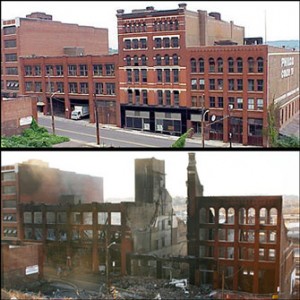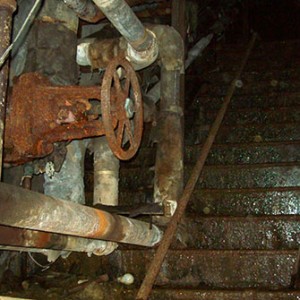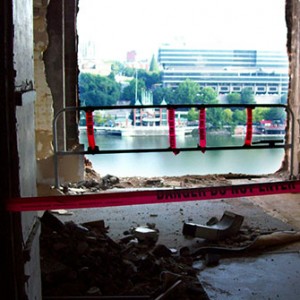Case Studies
A few selected samples from more than 20 years of work.
-
McClung Warehouses Demolition
Knoxville, TN -
Former Lakeshore Mental Health Institute
Knoxville, TN -
Former Baptist Hospital
Knoxville, TN
QE2 and a subcontractor performed emergency abatement of a steam line piping elbow in the Vocational Annex to allow for leak repairs. The task included obtaining subcontractors, coordinating after-hours abatement and clearance, and providing final inspections and reports.
QE2 also performed ACM and LBP Surveys in support of three different SBC projects including ADA Upgrades at the Ward Building, Steam Line and Boiler Replacements at three buildings, and ADA Upgrades in the Auditorium and Cafeteria areas. The tasks included sampling for ACM, testing for LBP with an x-ray fluorescence device, and providing reports with recommendations.
QE2 provided full hazardous materials survey work at Cottage E in support of a later SBC demolition project. The task included sampling for ACM, testing for LBP, inspecting and inventorying PCB-containing transformers and ballasts, hazardous chemicals, checking and testing steam lines in vaults, and mercury-containing bulbs and thermostats. After test results were received, ACM was quantified and abatement cost estimates were developed. QE2 later designed Demolition Plans and Specifications, including Specifications for abatement and engineering drawings, and a Storm Water Pollution Prevention Plan as part of an SBC project. QE2 oversaw demolition, which occurred in 2012-13.
In early 2012, QE2 was tasked to perform mold and moisture intrusion inspection in the TSD Gym Tower, where moisture- and mold-damaged drywall was noted following a renovation project. QE2 inspected the Tower, attended meetings with construction contractors, and provided recommendations for abatement and leak investigations.
As part of the requirements related to the Federal portion of funding for the new site, a National Environmental Policy Act (NEPA) assessment was needed. QE2 performed the work in cooperation with the U.S. and State of Tennessee Departments of Veterans Affairs, the Architects and Designers, STREAM, and specialized plant, animal, wetlands, archaeology and noise subcontractor consultants. The NEPA assessment included community and infrastructure impact studies, interviews with neighbors, geological evaluations, environmental impact studies, and archaeological excavations. The site was determined to be acceptable and all documentation was provided in time to meet critical Federal funding deadlines. The work was completed in 2010 and site construction began soon after. The new East Tennessee Veterans Cemetery was dedicated for service in 2011 and is now a functioning facility.
QE2 aided the State in compiling a presentation for the Tennessee Historical Commission and State Historic Preservation Officer in order to gain permission to demolish the potentially historically valuable structures.
QE2 performed hazardous materials assessments and coordinated abatement at the active correctional complex. QE2 also prepared a cost-effective bid package to facilitate partial demolition by a Contractor and partial demolition by prison inmates. QE2 worked with regulators to obtain the necessary abatement/demolition permit from the State of Tennessee Department of Environment and Conservation (TDEC), Division of Air Pollution Control (APC).
QE2 determined that the total disturbed area was small enough that a Stormwater Pollution Prevention Plan (SWPPP) and Permit was not required and coordinated approval of an on-site disposal area with the TDEC Division of Solid Waste Management (DSWM). At the State’s request, QE2 subcontracted the demolition and disposal activities after awarding the bid. QE2 coordinated off-site disposal of the abated materials, and ensured the Contractor fulfilled manifesting and disposal tickets to document the disposal of abated materials. In order to facilitate the use of inmate labor for demolition of various structures, work was coordinated with the prison’s warden and facility manager. QE2 coordinated with the prison staff to make arrangements for the inmate work crew to accomplish their tasks on schedule so as not to create delays and change orders for the Contractor. The structures were all abated and demolished and the project was finished on budget and on time.
During the summer of 2010, QE2 responded to occupant complaints of IAQ problems at the Carriage House. The task included air sampling for mold, dust, pollen, and dander; surface sampling for mold; inspections for potential moisture intrusion; and measuring temperature, humidity, ultrafine particles, CO, and CO2. While onsite, testing for radon was also performed in the basement, since radon issues had been previously documented at the Governor’s Mansion. (QE2 had designed a radon mitigation system for part of the Governor’s mansion prior ot this work at the carriage house.) The results of the investigations indicated that elevated mold levels existed in the basement, and that the basement air might occasionally enter the occupied spaces. Recommendations included sealing locations where unconditioned basement air may be mixing with upstairs air. The results of the radon testing indicated no elevated concentrations.
In November 2010, QE2 performed a full LBP survey in support of planned renovations to windows and paint at the site. The survey included testing with an x-ray fluorescence device and providing documentation and recommendations.
In the summer of 2011, under QE2’s direction, abatement subcontractors performed LBP and ACM abatement at the Carriage House. QE2 included developing and designing a scope of work, meeting potential subcontractors, evaluating bids and recommending a subcontractor, coordinating and overseeing abatement, and performing inspections and clearance. Abatement included the removal of deteriorating LBP from exterior porches, columns, and window frames; and the removal of deteriorating asbestos insulation from heat and air ducts.



